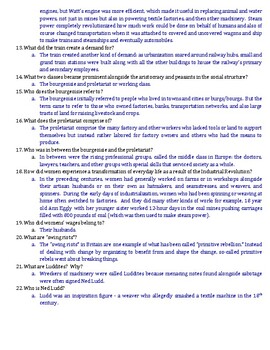- This lesson plan on the Industrial Revolution allows you to help students make connections between the first inventions of the 19th century and the great social changes that affected slavery.
- The maps capture the start of the massive growth of the city at the beginning of the industrial revolution. Mr Perkins said: 'In 1945 the Council planned a modernist utopia of straight roads, wide boulevards, roundabouts, and other civic buildings.' 'It was part of a 200-page vision for universal education, healthcare and low congestion.'
- The Industrial Revolution in Great Britain Although the Industrial Revolution evolved out of ante-cedents that occurred over a long period of time, histori-ans generally agree that it had its beginnings in Britain in the second half of the eighteenth century. By 1850, the Industrial Revolution had made Great Britain the wealth.
Industrial Revolution Educational Materials |
|---|
Industrial and industrial societies all over the world. As you readabout the changes caused by industrialization, note how reform movements eventually improve conditions for all laborers, including children. You are a 15-year-old living in England where the Industrial Revolution has spurred the growth of thousands of factories.
| This unit of free educational materials focuses on the Industrial Revolution in World History, from its origins in the Commercial Revolution, Scientific Revolution, and Intellectual Revolution, through advances in English cotton manufacturing, to its spread to continental Europe, the United States, and beyond. Particular attention is paid to inventors from the period, such as Arkwright, Hargreaves, Kay, Stephenson, Diesel, et al. The term Industrial Revolution was first popularized in the early 1880s by economic historian Arnold Toynbee (British, 1852-1883). |
| Industrial Revolution Outlines and Powerpoints |

| Industrial Revolution Worksheets |

| Industrial Revolution Maps and Pictures |
| Industrial Revolution Online Study Games |
| Industrial Revolution Miscellany |
| Industrial Revolution Books and Films |
The Industrial Revolutionmr Volkmar's Course Pages Blanches
Industrial Revolution Webquest
The Industrial Revolution Mr Volkmar's Course Pages Page
 Industrial Revolution Web quest
Industrial Revolution Web questThe Industrial Revolution was a time of dramatic change, from hand tools and handmade items, to products which were mass produced by machines. Workers became more productive. Since more items were manufactured, prices dropped, making exclusive and hard to make items available to the poor and not only the rich and elite. Life generally improved, but the Industrial Revolution also proved harmful. Pollution increased, working conditions were harmful, and factory owners employed women and young children, making them work long and hard hours. The Industrial Revolution was a time for change, for better or worse.
This WebQuest is dedicated to the Industrial Revolution, the changes that occurred, and how it effected modern life.
This WebQuest demonstrates the transition from hand tools to machines and shows the pros and cons of the revolution.
Before you begin your assignment, read over the directions:
You will be completing this assignment without paper and pencil.
Make sure that you increase the spacing between the questions.
You will turn in a completed word document upon completion.
Utilize the resources at the bottom of the page to complete this assignment.
Answer in: complete sentences, bullets, graphics
- Copy and paste questions into Open Office word document.
- Answer questions and save work to flash drive or 365.
- When done, print work and submit to homework bin.
1. What was the Industrial Revolution?
2. Describe what child labor is.
3. What was the common age range for child labor?
4. What was the pay per week?
5. How many were employed in the United States?
6. Create a list that describes the working conditions in factories. At least 5 conditions.
7. What was the class (wealth) structure and where did they live?
8. Find 2 inventors and discuss: a. Who were they? b. What did they invent? c. When was their invention created? d. Where was it created? e. Why was it important at that time? f. How did it influence today?
9. What were Labor unions used for? Who did they represent?
10. Where did most of the people live? Why?
11. What roles did women play in the Industrial Revolution? How
does that differ from today?
12. Compile a list of 5 inventions and describe why they were
important.
13. Define: a. anarchism b. capitalism c. socialism d. communism
14.Compare and contrast any two of the political theories from above ( letters a, b, c, d)
15. Choose one of the companies (below) accused of abusive labor, and provide information that would support these claims.(5 specific facts)
Labor Issues Today- Some of todays companies have been accused of profiting from abusive labor. Nike Disney Hyundai Guess Wal‐Mart Kmart J.C. Penney Victoria Secret Limited Espirit CBS aired a “48Hours” special report on Nikes factory operations in Vietnam.
According to the report, 15 Vietnamese women told CBS New that they were hit over the head by their supervisors for poor sewing. Two were sent to the hospital afterward. Forty‐five women were forced by their supervisors to kneel down with their hands up in the air for 25 minutes.
Resources for Webquest:
Growth of Cities:
Migration During the Industrial Revolutio (population shifts)
History of Internation Migration: Industrial Revolution
Working Conditions:
The Life of the Industrial Worker in NinteenthCentury England
Role of Women:
Women and Children in the Industrial Revolution
The Plight of Women's Work in the Early Industrial Revolution in England and Wales
Child Labor:
Women and Children in the Industrial Revolution
Child Labour
Child Labor and the Industrial Revolution
Health and Sanitation:
Diseases in the Industrial Cities
Disease During the Industrial Revolution
Public Health During theIndustrial Revolution
Chadwick's Report on Sanitary Conditions (Primary Source)
Income:
Earning a living
Labor Unions:
Bricklayers Union
Association of Cotton Spinners
Agricultural Laborers Union
Impact of inventions:
Textile Industry
Signs of the Times: The 'Mechanical Age'
Seamstresses: Industrial Revolution (Primary Source)
General Info.:
http://www.kidinfo.com/American_History/Industrial_Revolution.html
The Industrial Revolutionmr Volkmar's Course Pages Search
Industrial Revolution Background InformationThe Industrial Revolutionmr Volkmar's Course Pages Page
